BBUS1003 Intercultural Communication Case Study Report
VerifiedAdded on 2023/03/23
|6
|1513
|94
Case Study
AI Summary
This case study report delves into the complexities of intercultural communication within a business context, addressing the various barriers that impede effective interaction. It begins by outlining the three levels of culture: artifacts and behavior, values, and assumptions and beliefs, highlighting their impact on communication. The report then explores the intricate relationship between language and culture, emphasizing how language shapes perceptions and values. Key barriers to intercultural communication, such as stereotyping, ethnocentrism, and presentation issues, are examined in detail, providing examples of their manifestation in the workplace. The report also discusses the importance of understanding cultural diversity and inclusion policies, using Tesco as an example of a company actively addressing cultural differences. Finally, the study suggests strategies for overcoming these barriers, including fostering involvement and ensuring equal treatment across cultures. Desklib provides access to this and other solved assignments to aid students in their studies.
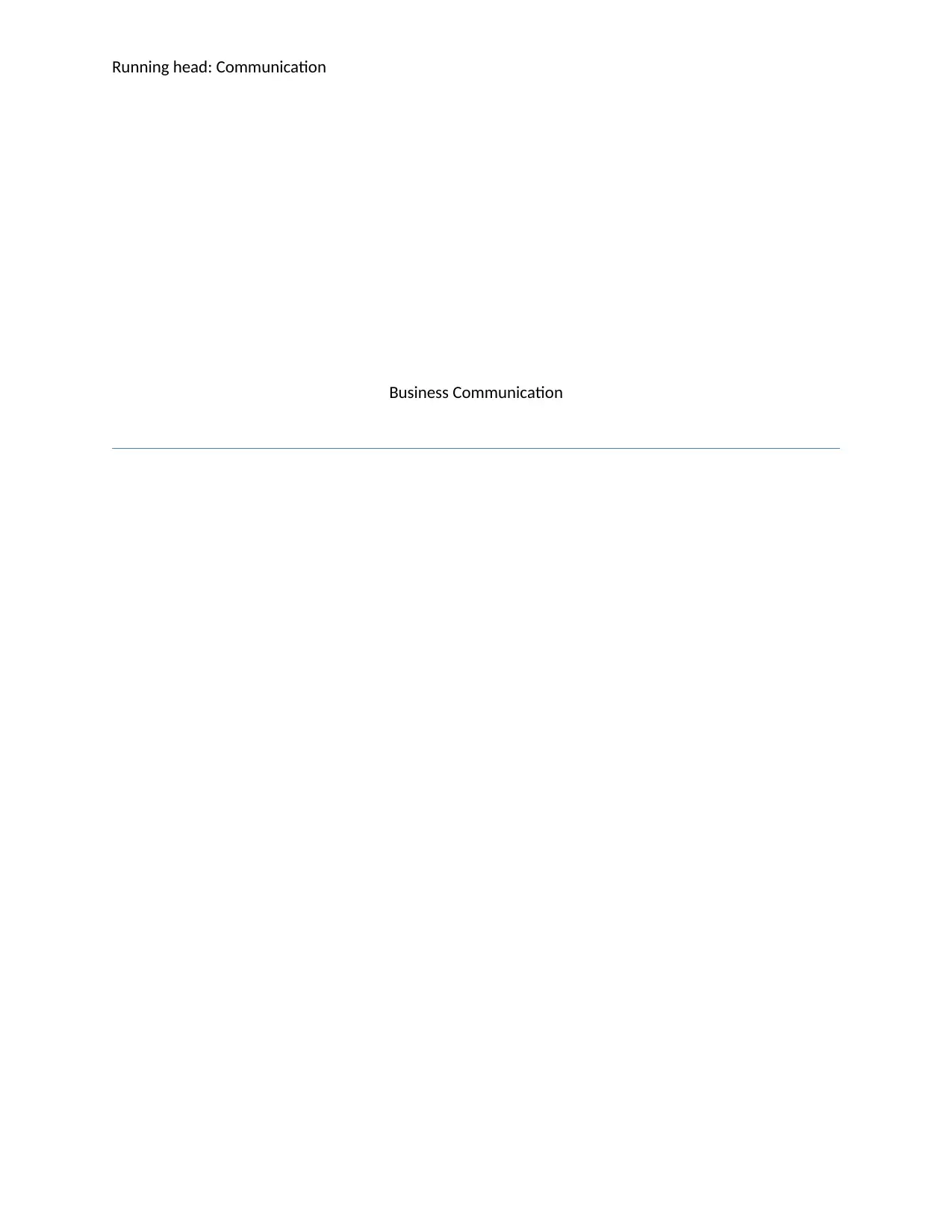
Running head: Communication
Business Communication
Business Communication
Paraphrase This Document
Need a fresh take? Get an instant paraphrase of this document with our AI Paraphraser
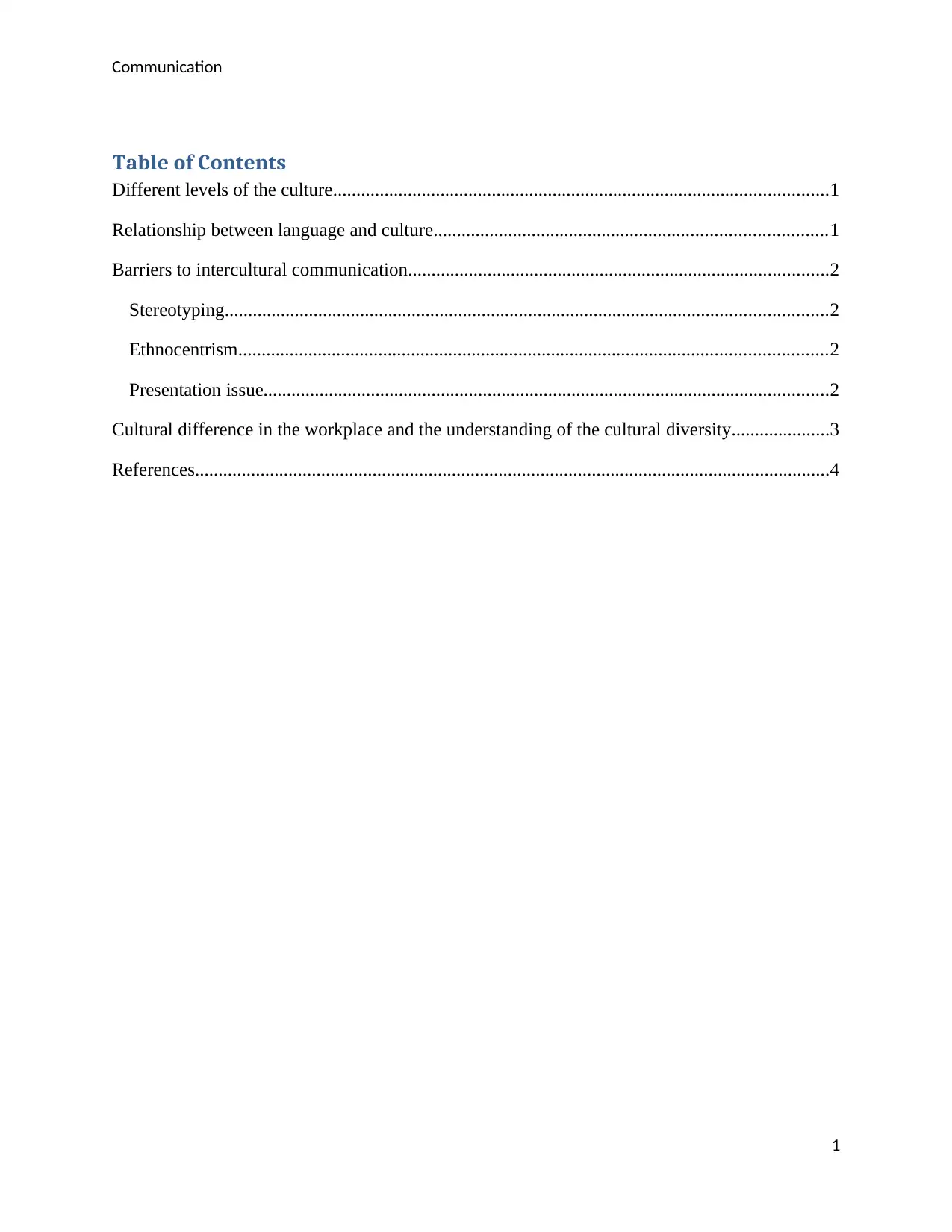
Communication
Table of Contents
Different levels of the culture..........................................................................................................1
Relationship between language and culture....................................................................................1
Barriers to intercultural communication..........................................................................................2
Stereotyping.................................................................................................................................2
Ethnocentrism..............................................................................................................................2
Presentation issue.........................................................................................................................2
Cultural difference in the workplace and the understanding of the cultural diversity.....................3
References........................................................................................................................................4
1
Table of Contents
Different levels of the culture..........................................................................................................1
Relationship between language and culture....................................................................................1
Barriers to intercultural communication..........................................................................................2
Stereotyping.................................................................................................................................2
Ethnocentrism..............................................................................................................................2
Presentation issue.........................................................................................................................2
Cultural difference in the workplace and the understanding of the cultural diversity.....................3
References........................................................................................................................................4
1
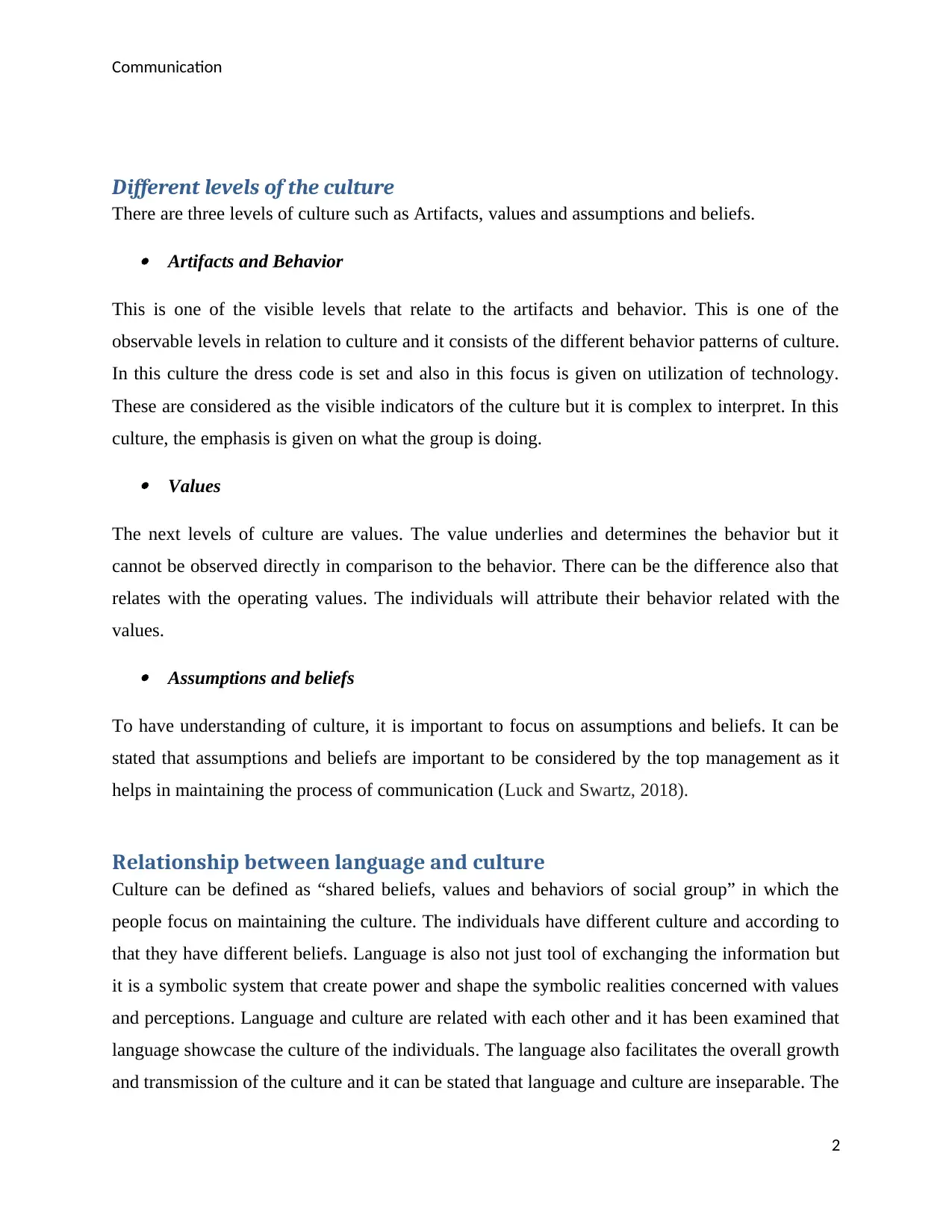
Communication
Different levels of the culture
There are three levels of culture such as Artifacts, values and assumptions and beliefs.
Artifacts and Behavior
This is one of the visible levels that relate to the artifacts and behavior. This is one of the
observable levels in relation to culture and it consists of the different behavior patterns of culture.
In this culture the dress code is set and also in this focus is given on utilization of technology.
These are considered as the visible indicators of the culture but it is complex to interpret. In this
culture, the emphasis is given on what the group is doing.
Values
The next levels of culture are values. The value underlies and determines the behavior but it
cannot be observed directly in comparison to the behavior. There can be the difference also that
relates with the operating values. The individuals will attribute their behavior related with the
values.
Assumptions and beliefs
To have understanding of culture, it is important to focus on assumptions and beliefs. It can be
stated that assumptions and beliefs are important to be considered by the top management as it
helps in maintaining the process of communication (Luck and Swartz, 2018).
Relationship between language and culture
Culture can be defined as “shared beliefs, values and behaviors of social group” in which the
people focus on maintaining the culture. The individuals have different culture and according to
that they have different beliefs. Language is also not just tool of exchanging the information but
it is a symbolic system that create power and shape the symbolic realities concerned with values
and perceptions. Language and culture are related with each other and it has been examined that
language showcase the culture of the individuals. The language also facilitates the overall growth
and transmission of the culture and it can be stated that language and culture are inseparable. The
2
Different levels of the culture
There are three levels of culture such as Artifacts, values and assumptions and beliefs.
Artifacts and Behavior
This is one of the visible levels that relate to the artifacts and behavior. This is one of the
observable levels in relation to culture and it consists of the different behavior patterns of culture.
In this culture the dress code is set and also in this focus is given on utilization of technology.
These are considered as the visible indicators of the culture but it is complex to interpret. In this
culture, the emphasis is given on what the group is doing.
Values
The next levels of culture are values. The value underlies and determines the behavior but it
cannot be observed directly in comparison to the behavior. There can be the difference also that
relates with the operating values. The individuals will attribute their behavior related with the
values.
Assumptions and beliefs
To have understanding of culture, it is important to focus on assumptions and beliefs. It can be
stated that assumptions and beliefs are important to be considered by the top management as it
helps in maintaining the process of communication (Luck and Swartz, 2018).
Relationship between language and culture
Culture can be defined as “shared beliefs, values and behaviors of social group” in which the
people focus on maintaining the culture. The individuals have different culture and according to
that they have different beliefs. Language is also not just tool of exchanging the information but
it is a symbolic system that create power and shape the symbolic realities concerned with values
and perceptions. Language and culture are related with each other and it has been examined that
language showcase the culture of the individuals. The language also facilitates the overall growth
and transmission of the culture and it can be stated that language and culture are inseparable. The
2
⊘ This is a preview!⊘
Do you want full access?
Subscribe today to unlock all pages.

Trusted by 1+ million students worldwide
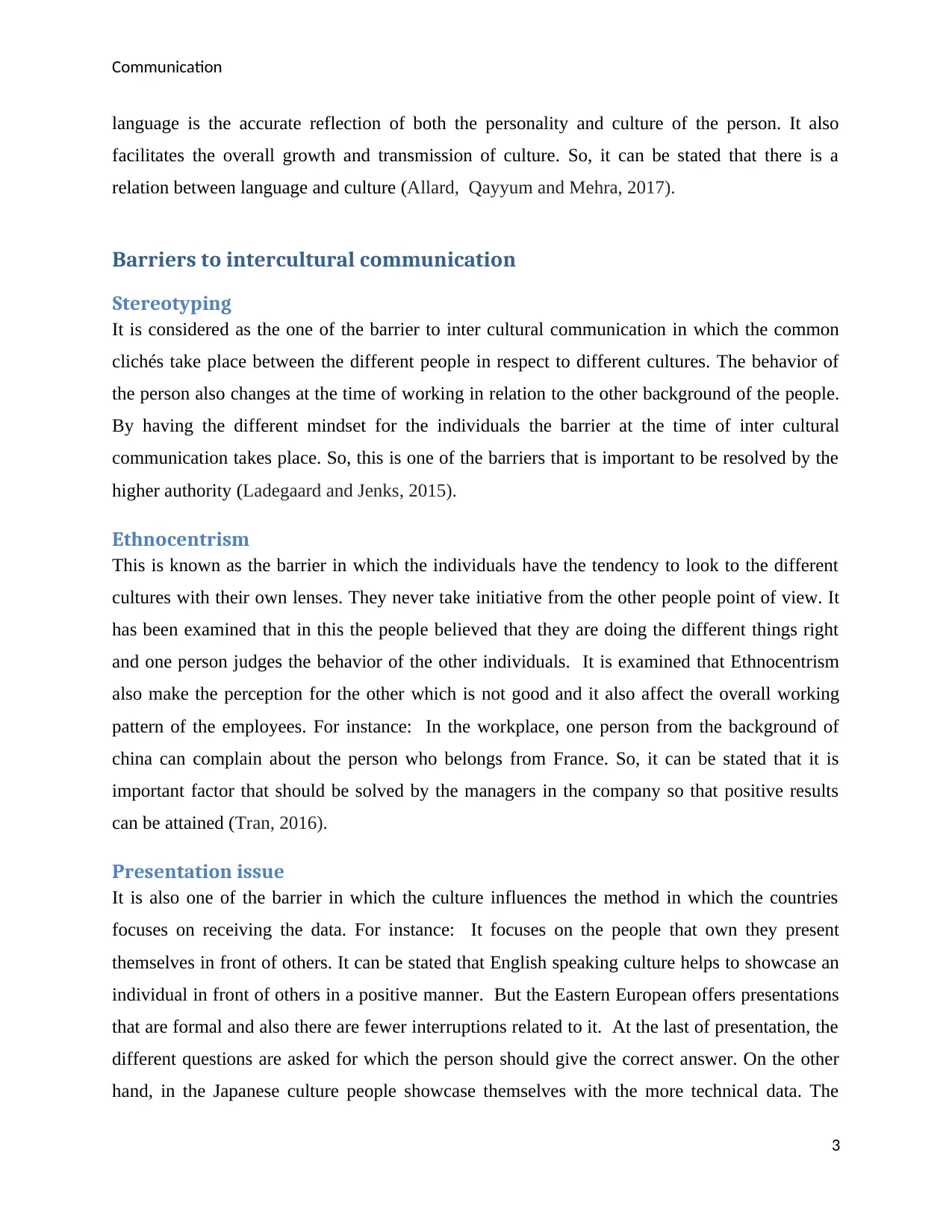
Communication
language is the accurate reflection of both the personality and culture of the person. It also
facilitates the overall growth and transmission of culture. So, it can be stated that there is a
relation between language and culture (Allard, Qayyum and Mehra, 2017).
Barriers to intercultural communication
Stereotyping
It is considered as the one of the barrier to inter cultural communication in which the common
clichés take place between the different people in respect to different cultures. The behavior of
the person also changes at the time of working in relation to the other background of the people.
By having the different mindset for the individuals the barrier at the time of inter cultural
communication takes place. So, this is one of the barriers that is important to be resolved by the
higher authority (Ladegaard and Jenks, 2015).
Ethnocentrism
This is known as the barrier in which the individuals have the tendency to look to the different
cultures with their own lenses. They never take initiative from the other people point of view. It
has been examined that in this the people believed that they are doing the different things right
and one person judges the behavior of the other individuals. It is examined that Ethnocentrism
also make the perception for the other which is not good and it also affect the overall working
pattern of the employees. For instance: In the workplace, one person from the background of
china can complain about the person who belongs from France. So, it can be stated that it is
important factor that should be solved by the managers in the company so that positive results
can be attained (Tran, 2016).
Presentation issue
It is also one of the barrier in which the culture influences the method in which the countries
focuses on receiving the data. For instance: It focuses on the people that own they present
themselves in front of others. It can be stated that English speaking culture helps to showcase an
individual in front of others in a positive manner. But the Eastern European offers presentations
that are formal and also there are fewer interruptions related to it. At the last of presentation, the
different questions are asked for which the person should give the correct answer. On the other
hand, in the Japanese culture people showcase themselves with the more technical data. The
3
language is the accurate reflection of both the personality and culture of the person. It also
facilitates the overall growth and transmission of culture. So, it can be stated that there is a
relation between language and culture (Allard, Qayyum and Mehra, 2017).
Barriers to intercultural communication
Stereotyping
It is considered as the one of the barrier to inter cultural communication in which the common
clichés take place between the different people in respect to different cultures. The behavior of
the person also changes at the time of working in relation to the other background of the people.
By having the different mindset for the individuals the barrier at the time of inter cultural
communication takes place. So, this is one of the barriers that is important to be resolved by the
higher authority (Ladegaard and Jenks, 2015).
Ethnocentrism
This is known as the barrier in which the individuals have the tendency to look to the different
cultures with their own lenses. They never take initiative from the other people point of view. It
has been examined that in this the people believed that they are doing the different things right
and one person judges the behavior of the other individuals. It is examined that Ethnocentrism
also make the perception for the other which is not good and it also affect the overall working
pattern of the employees. For instance: In the workplace, one person from the background of
china can complain about the person who belongs from France. So, it can be stated that it is
important factor that should be solved by the managers in the company so that positive results
can be attained (Tran, 2016).
Presentation issue
It is also one of the barrier in which the culture influences the method in which the countries
focuses on receiving the data. For instance: It focuses on the people that own they present
themselves in front of others. It can be stated that English speaking culture helps to showcase an
individual in front of others in a positive manner. But the Eastern European offers presentations
that are formal and also there are fewer interruptions related to it. At the last of presentation, the
different questions are asked for which the person should give the correct answer. On the other
hand, in the Japanese culture people showcase themselves with the more technical data. The
3
Paraphrase This Document
Need a fresh take? Get an instant paraphrase of this document with our AI Paraphraser
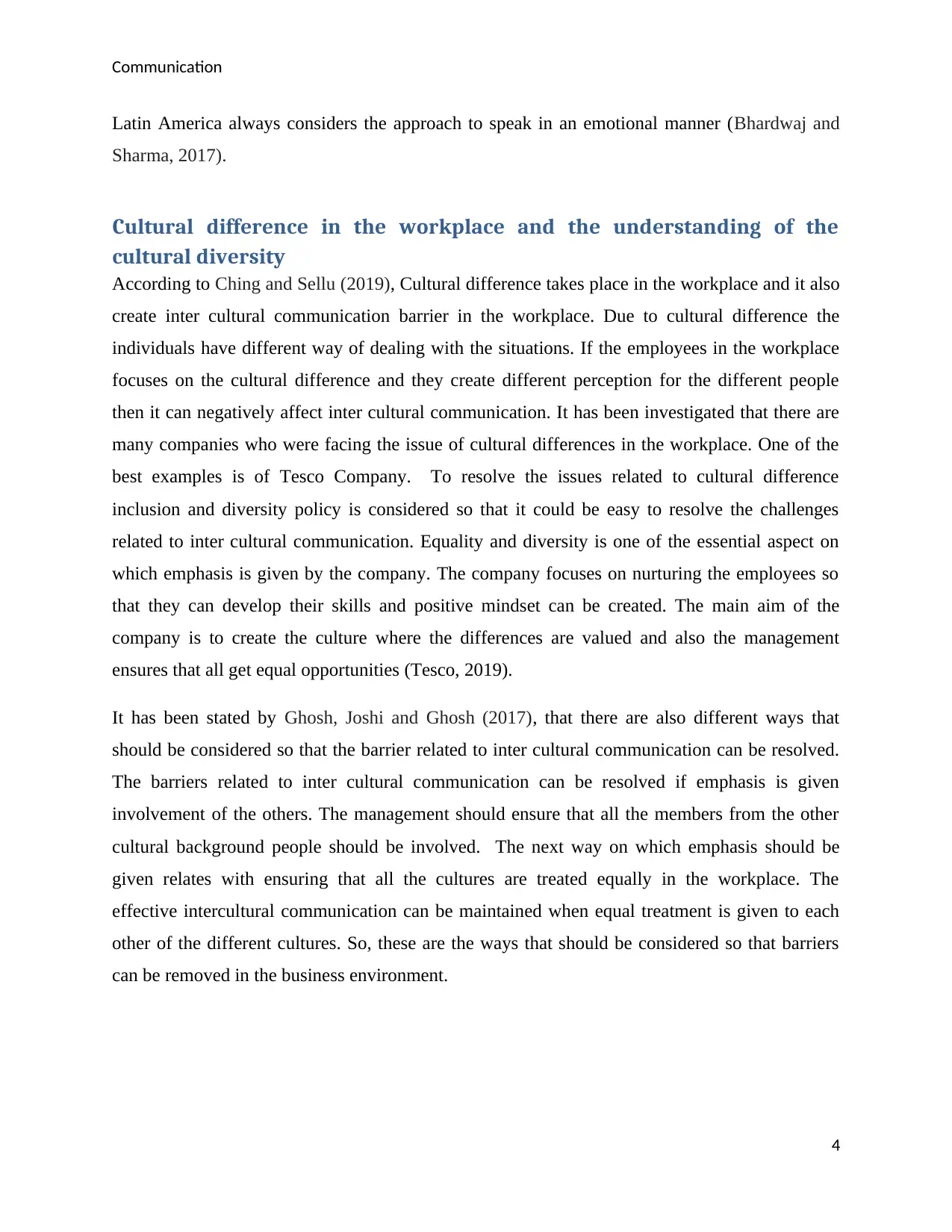
Communication
Latin America always considers the approach to speak in an emotional manner (Bhardwaj and
Sharma, 2017).
Cultural difference in the workplace and the understanding of the
cultural diversity
According to Ching and Sellu (2019), Cultural difference takes place in the workplace and it also
create inter cultural communication barrier in the workplace. Due to cultural difference the
individuals have different way of dealing with the situations. If the employees in the workplace
focuses on the cultural difference and they create different perception for the different people
then it can negatively affect inter cultural communication. It has been investigated that there are
many companies who were facing the issue of cultural differences in the workplace. One of the
best examples is of Tesco Company. To resolve the issues related to cultural difference
inclusion and diversity policy is considered so that it could be easy to resolve the challenges
related to inter cultural communication. Equality and diversity is one of the essential aspect on
which emphasis is given by the company. The company focuses on nurturing the employees so
that they can develop their skills and positive mindset can be created. The main aim of the
company is to create the culture where the differences are valued and also the management
ensures that all get equal opportunities (Tesco, 2019).
It has been stated by Ghosh, Joshi and Ghosh (2017), that there are also different ways that
should be considered so that the barrier related to inter cultural communication can be resolved.
The barriers related to inter cultural communication can be resolved if emphasis is given
involvement of the others. The management should ensure that all the members from the other
cultural background people should be involved. The next way on which emphasis should be
given relates with ensuring that all the cultures are treated equally in the workplace. The
effective intercultural communication can be maintained when equal treatment is given to each
other of the different cultures. So, these are the ways that should be considered so that barriers
can be removed in the business environment.
4
Latin America always considers the approach to speak in an emotional manner (Bhardwaj and
Sharma, 2017).
Cultural difference in the workplace and the understanding of the
cultural diversity
According to Ching and Sellu (2019), Cultural difference takes place in the workplace and it also
create inter cultural communication barrier in the workplace. Due to cultural difference the
individuals have different way of dealing with the situations. If the employees in the workplace
focuses on the cultural difference and they create different perception for the different people
then it can negatively affect inter cultural communication. It has been investigated that there are
many companies who were facing the issue of cultural differences in the workplace. One of the
best examples is of Tesco Company. To resolve the issues related to cultural difference
inclusion and diversity policy is considered so that it could be easy to resolve the challenges
related to inter cultural communication. Equality and diversity is one of the essential aspect on
which emphasis is given by the company. The company focuses on nurturing the employees so
that they can develop their skills and positive mindset can be created. The main aim of the
company is to create the culture where the differences are valued and also the management
ensures that all get equal opportunities (Tesco, 2019).
It has been stated by Ghosh, Joshi and Ghosh (2017), that there are also different ways that
should be considered so that the barrier related to inter cultural communication can be resolved.
The barriers related to inter cultural communication can be resolved if emphasis is given
involvement of the others. The management should ensure that all the members from the other
cultural background people should be involved. The next way on which emphasis should be
given relates with ensuring that all the cultures are treated equally in the workplace. The
effective intercultural communication can be maintained when equal treatment is given to each
other of the different cultures. So, these are the ways that should be considered so that barriers
can be removed in the business environment.
4
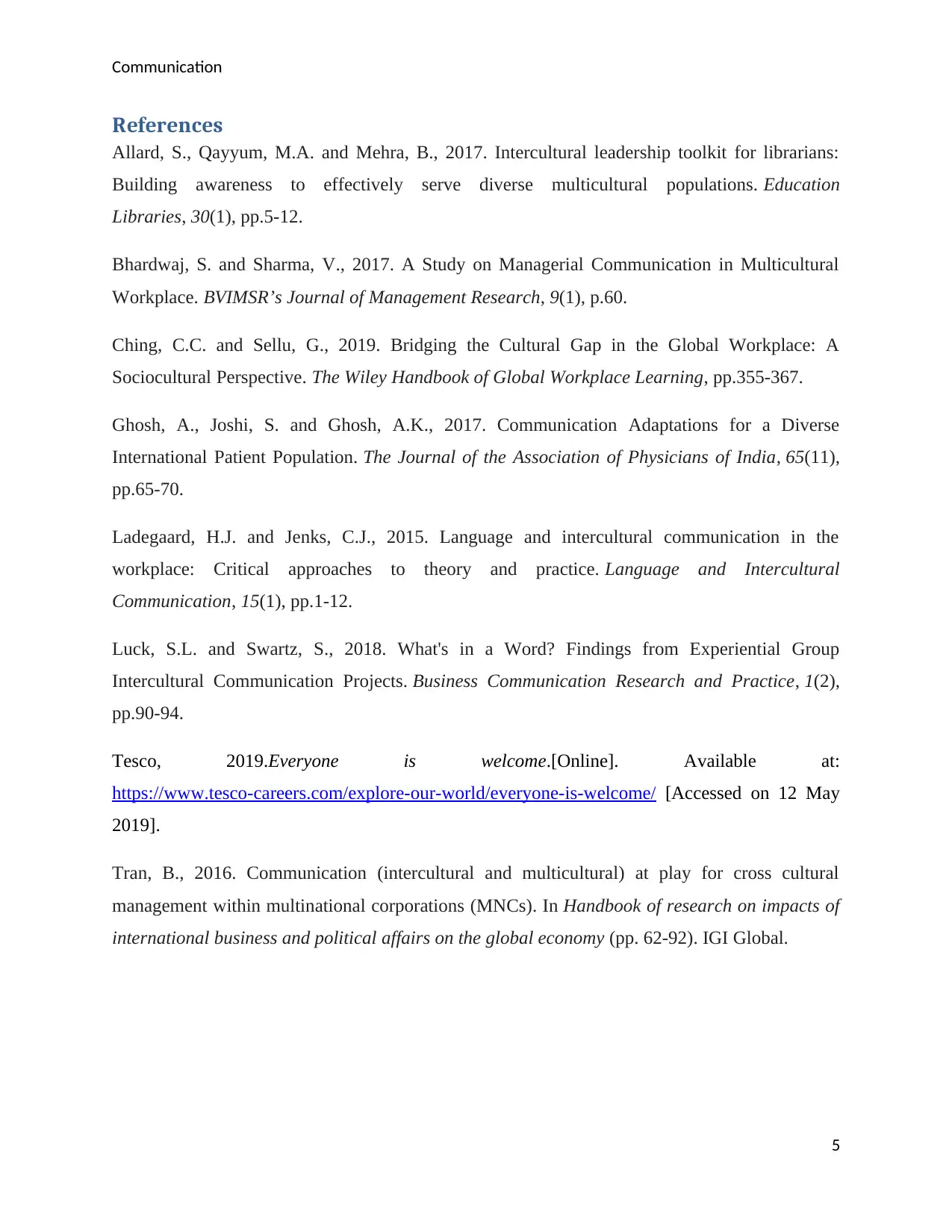
Communication
References
Allard, S., Qayyum, M.A. and Mehra, B., 2017. Intercultural leadership toolkit for librarians:
Building awareness to effectively serve diverse multicultural populations. Education
Libraries, 30(1), pp.5-12.
Bhardwaj, S. and Sharma, V., 2017. A Study on Managerial Communication in Multicultural
Workplace. BVIMSR’s Journal of Management Research, 9(1), p.60.
Ching, C.C. and Sellu, G., 2019. Bridging the Cultural Gap in the Global Workplace: A
Sociocultural Perspective. The Wiley Handbook of Global Workplace Learning, pp.355-367.
Ghosh, A., Joshi, S. and Ghosh, A.K., 2017. Communication Adaptations for a Diverse
International Patient Population. The Journal of the Association of Physicians of India, 65(11),
pp.65-70.
Ladegaard, H.J. and Jenks, C.J., 2015. Language and intercultural communication in the
workplace: Critical approaches to theory and practice. Language and Intercultural
Communication, 15(1), pp.1-12.
Luck, S.L. and Swartz, S., 2018. What's in a Word? Findings from Experiential Group
Intercultural Communication Projects. Business Communication Research and Practice, 1(2),
pp.90-94.
Tesco, 2019.Everyone is welcome.[Online]. Available at:
https://www.tesco-careers.com/explore-our-world/everyone-is-welcome/ [Accessed on 12 May
2019].
Tran, B., 2016. Communication (intercultural and multicultural) at play for cross cultural
management within multinational corporations (MNCs). In Handbook of research on impacts of
international business and political affairs on the global economy (pp. 62-92). IGI Global.
5
References
Allard, S., Qayyum, M.A. and Mehra, B., 2017. Intercultural leadership toolkit for librarians:
Building awareness to effectively serve diverse multicultural populations. Education
Libraries, 30(1), pp.5-12.
Bhardwaj, S. and Sharma, V., 2017. A Study on Managerial Communication in Multicultural
Workplace. BVIMSR’s Journal of Management Research, 9(1), p.60.
Ching, C.C. and Sellu, G., 2019. Bridging the Cultural Gap in the Global Workplace: A
Sociocultural Perspective. The Wiley Handbook of Global Workplace Learning, pp.355-367.
Ghosh, A., Joshi, S. and Ghosh, A.K., 2017. Communication Adaptations for a Diverse
International Patient Population. The Journal of the Association of Physicians of India, 65(11),
pp.65-70.
Ladegaard, H.J. and Jenks, C.J., 2015. Language and intercultural communication in the
workplace: Critical approaches to theory and practice. Language and Intercultural
Communication, 15(1), pp.1-12.
Luck, S.L. and Swartz, S., 2018. What's in a Word? Findings from Experiential Group
Intercultural Communication Projects. Business Communication Research and Practice, 1(2),
pp.90-94.
Tesco, 2019.Everyone is welcome.[Online]. Available at:
https://www.tesco-careers.com/explore-our-world/everyone-is-welcome/ [Accessed on 12 May
2019].
Tran, B., 2016. Communication (intercultural and multicultural) at play for cross cultural
management within multinational corporations (MNCs). In Handbook of research on impacts of
international business and political affairs on the global economy (pp. 62-92). IGI Global.
5
⊘ This is a preview!⊘
Do you want full access?
Subscribe today to unlock all pages.

Trusted by 1+ million students worldwide
1 out of 6
Related Documents
Your All-in-One AI-Powered Toolkit for Academic Success.
+13062052269
info@desklib.com
Available 24*7 on WhatsApp / Email
![[object Object]](/_next/static/media/star-bottom.7253800d.svg)
Unlock your academic potential
Copyright © 2020–2025 A2Z Services. All Rights Reserved. Developed and managed by ZUCOL.





